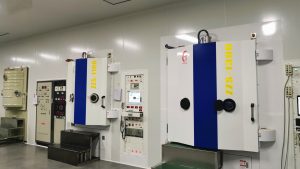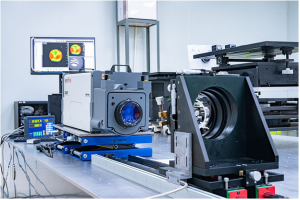The so-called narrowband filter is subdivided from the band-pass filter. Its definition is the same as that of the band-pass filter. That is, this filter allows the optical signal to pass in a specific band, while the optical signal on both sides outside the band is blocked. The passband of the narrowband filter is relatively narrow, generally less than 5% of the central wavelength value.
Parameter description of narrowband filter:
1. Center wavelength
The central wavelength of the narrowband filter is generally the working wavelength of the instrument or equipment, which refers to the wavelength at the center of the passband.
In the actual production process, there is always a little difference between the position of the central wavelength and the design value, so a tolerance range should be added when specifying the central wavelength. This tolerance range is determined by actual usage conditions. Generally, the narrower the bandwidth, the smaller the tolerance. For example, for a bandwidth of about 10 nm, the tolerance of the central wavelength is generally only allowed to ± 2 nm, and for a bandwidth of more than 30 nm, it can be relaxed to ± 5 nm.
2. Bandwidth
Bandwidth refers to the distance between two positions in the passband where the transmittance is half of the peak transmittance. Sometimes it is also called half-width (not called half-width). English letters are often expressed with FWHM (Full Width at Half Maximum). Specific bandwidth value definition: FWHM= λ R- λ L
Bandwidth also has tolerance, and its tolerance range is also related to the size of the bandwidth itself. Generally speaking, the smaller the bandwidth, the smaller the tolerance. The selection of bandwidth is related to the light source used, the required signal wavelength range and the size of interference.
3. Peak transmittance
The peak transmittance refers to the high transmittance of the bandpass filter in the passband. The requirements for peak transmittance vary according to the application situation. In the requirements of noise suppression and signal size, if we pay more attention to the signal size and hope to improve the signal strength, in this case, we need high peak transmittance. If we pay more attention to noise suppression and hope to obtain higher signal-to-noise ratio, we can reduce the requirements of some peak transmittance and improve the requirements of cutoff depth.
4. Deadline
Cut-off range refers to the wavelength range required to be cut off except the passband. For narrow-band filters, there is a front cutoff, that is, the cutoff wavelength is less than the central wavelength, and there is a long cutoff, that is, the cutoff wavelength is higher than the central wavelength. If it is subdivided, it is necessary to describe the two cut-off bands separately, but in general, the cut-off range of the narrow band filter can be known by specifying the short wavelength and the long wavelength that the narrow band filter needs to cut off. When determining the cut-off range, we can’t simply say “nothing but passband is needed”. This description is too idealistic and will cause trouble in the actual production process.
The selection of cut-off range is related to the light source used, the wavelength range of interference light and the spectral response range of the instrument used.
5. Cut-off depth
Cut-off depth refers to the maximum transmittance of the light that can be transmitted in the cut-off band. Different application systems have different requirements for the cut-off depth. For example, for use in the case of excitation fluorescence, the cut-off depth is generally required to be less than T < 0.001%. In common monitoring and identification systems, the cut-off depth T < 0.5% is sometimes sufficient. The specific cut-off depth depends on the intensity of the light source, the size of the interference light and the demand for the signal-to-noise ratio. Similarly, when determining the cutoff depth index, we cannot say that “all light transmittance of the cutoff band is zero except the passband!”
For simplicity, the cut-off depth is often expressed by the OD value. Relationship between OD value and transmittance: OD=㏒ T
For example, if T<0.01%, the transmittance is 10-4, and the corresponding OD value is 4. If T<1%, the corresponding OD value is 2
6. Incidence angle
The incident angle refers to the angle between the incident light and the normal of the filter.
Do not misunderstand the incident angle as the angle between the line between the light source position and the center of the filter and the normal of the filter. If there is no collimated light path, even if the light source is installed on the central normal of the filter, the light is still divergent, that is, the incidence angle will not be 0 °.
If the angle between the incident light and the normal of the filter has a certain range, the specific range of the angle should be specified, because the design of the interference filter is very sensitive to the angle. For the narrowband filter designed at 0 °, if used at different angles, the effect is completely different. Some users will reflect that when shooting an object with a wide-angle lens, after adding a narrow-band filter, they found that only the objects in the middle part can be shot, and the objects on the edge are very dark. They thought that the narrow-band filter is only transparent in the middle, and the edge is not transparent. This understanding is wrong. The whole surface of the narrow-band filter is uniform, mainly because the light transmission band of the filter moves to the short wave when the incident angle is large, and the short wave part has no light source.
The above six parameters must be taken into account when using and selecting narrowband filters. Different performance indicators require different manufacturing costs of filters.



